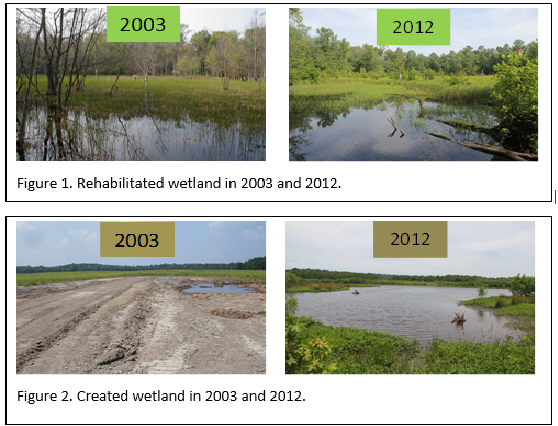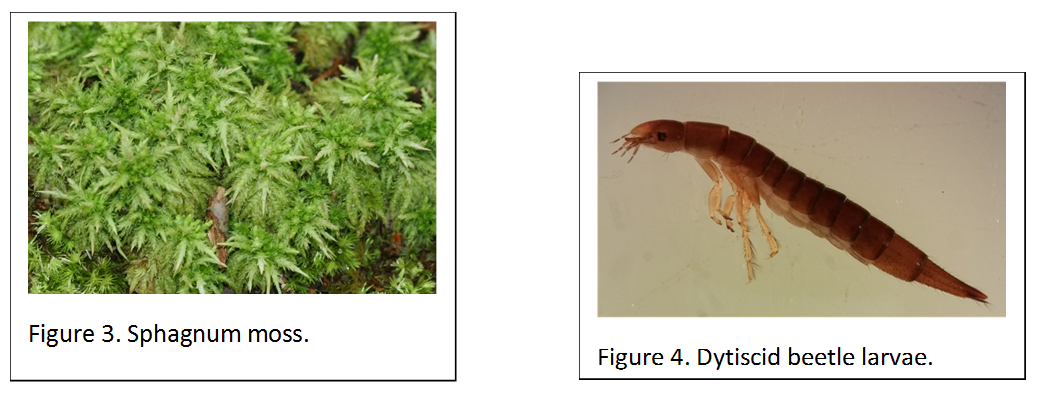|
If you take a drive along the Eastern Shore of Maryland, you will likely pass many wetlands. Called Delmarva bays, these wetlands are seasonal, meaning that they dry out every summer. Consequently, fish cannot survive in most of these wetlands, and the food webs are mainly composed of aquatic invertebrates. Delmarva bays have become the focus of recent restoration efforts under organizations such as the Nature Conservancy. Over the years, many of these wetlands have been impaired or destroyed by agricultural activity. This is problematic, as Delmarva bays perform many important ecosystem services, such as retaining nutrients that would otherwise enter the Chesapeake Bay. A central goal of restoration efforts is to reestablish these services. As PhD candidate, Ellie Spadafora of the Lamp Lab learned, however, determining the success of wetland restoration can depend a lot on when and how you measure it. Spadafora first wanted to examine the community level changes between three types of wetlands: natural, rehabilitated, and created. The rehabilitated and created wetlands differed in that the rehabilitated wetland had once been a wetland in the past while the created wetland was constructed in a forested depression. The created and rehabilitated wetlands were restored and built, respectively, in 2003, and monitoring of invertebrate populations began soon after. How much had they changed, and begun to resemble the historic wetland, from 2003 until the start of her research in 2012? Visually, the restored wetlands looked much healthier after 9 years, as seen in the comparison in figures 1 and 2. Do these visual changes mean anything for the biological composition of the wetlands? Spadafora compared the aquatic invertebrates sampled in the wetlands over time and found some encouraging results. The most abundant invertebrate in the natural wetland across all years was a freshwater isopod, Asellus. The created wetland, in contrast, had non-biting midge larvae (Family Chironomidae) in abundance every year. The rehabilitated wetland was the most interesting. Although in its earlier years the invertebrate community was dominated by midge larvae, by 2012 Asellus accounted for the majority of the specimens. This may suggest that if the goal of a wetland restoration project is to achieve similar characteristics to natural wetlands, rehabilitating former wetlands may be a better plan than creating new ones. However, her results did indicate that success cannot necessarily be determined immediately following restoration. Longer term monitoring may be needed to see improvements. So what was different about the rehabilitated and created wetlands? Spadafora hypothesized it may have something to do with a moss. Naturally occurring sphagnum moss (figure 3) may be most recognizable as a base for floral arrangements, but it also serves as an important ecosystem engineer by providing habitat structure for aquatic invertebrates, such as isopods and predaceous diving beetles (Family Dytiscidae, figure 4). Sphagnum also appeared in the rehabilitated wetland in 2009, which is the time period where isopods became dominant in the invertebrate community. To test her theory that sphagnum influences invertebrate communities, she expanded her study to include twenty Delmarva Bays (ten with sphagnum, ten without) and shifted her taxonomic focus to Dytiscid beetles. Although not as abundant as the isopods, these Dytiscid beetles are crucial for Delmarva bay ecosystems because, in the absence of fish, they are one of the top predators. If sphagnum mosses were influencing beetle diversity, she expected to see more species of beetles in the sphagnum wetlands. Indeed, beetle diversity was higher in the moss-containing wetlands, and interestingly some species were only found in either the sphagnum or non-sphagnum sites. Spadafora’s research provides us with some excellent takeaways regarding wetland restoration. In addition to making the rehabilitated wetland look more like a genuine Delmarva bay, the sphagnum may also allow it to support a larger array of aquatic insects and maintain diversity of a disappearing habitat type.
For more information, check out Ellie Spadafora’s recent publication in Restoration Ecology. About the author: Becca Wilson is a PhD candidate in the Lamp Lab. She studies the spatial distribution and societal impacts of nuisance black flies in western Maryland. Comments are closed.
|
Categories
All
Archives
June 2024
|
Department of Entomology
University of Maryland
4112 Plant Sciences Building
College Park, MD 20742-4454
USA
Telephone: 301.405.3911
Fax: 301.314.9290
University of Maryland
4112 Plant Sciences Building
College Park, MD 20742-4454
USA
Telephone: 301.405.3911
Fax: 301.314.9290



 RSS Feed
RSS Feed




